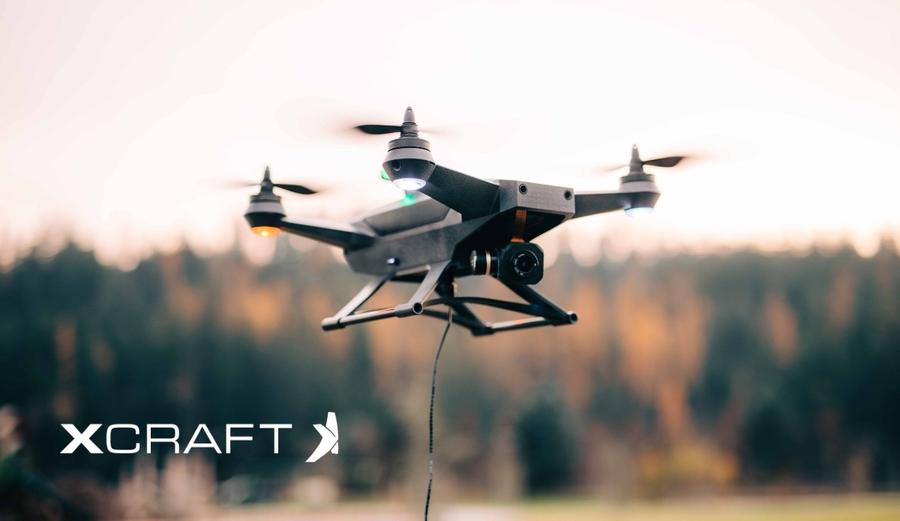When people think of drones, they usually envision small unmanned aerial vehicles (UAVs) that are able to hover and zoom about like mini spacecraft. So it might come as a surprise not only that not all UAVs are designed that way, but that, in certain applications, tethered drones (or leashed drones) can outshine their free-flying brethren. So in searching for what type of UAV is the best option for your particular application, you should familiarize yourself with the advantages and limitations of tethered drones versus free-flying drones.
Safe in Crowds
UAVs are very useful when you need to get a video surveillance or survey of an area, because it is relatively easy and quick to get a drone into the air and into spaces where manned aircraft either cannot go or should not go.
But while tales of runaway drones are uncommon, a free-flying drone can be less than ideal, and even dangerous, in the hands of an unprepared pilot. When using a drone to capture footage of natural disasters, war zones, or protests, free-flying drones require a skillful pilot to operate it safely. But even then, you are not out of the woods. Strong winds, flying objects, and other unexpected events may cause the pilot to lose control of the drone.
Free-flying drones can also be piloted where they should not go–including restricted airspace and restricted property. Free-flying drones may also hit high-voltage power lines, trees, or even people and animals, causing problems, injury, and perhaps even legal liability for their owners.
In contrast, tethered UAVs can be deployed where you can conscientiously avoid these problems. Since you know the exact reach of a tether, you can make sure that there are no obstructions or dangers to the drone or to others within the range of the drone. What is more, because control of the drone is through a tether, you can usually pre-program the drone for flight-time and return, meaning that you can virtually “set it and forget it” while you focus on other aspects of your drone deployment. This is especially useful if you are a journalist or photographer working solo: you don’t have to spend all your time piloting the UAV, but can focus on your core purpose.
For example, xCraft’s Panadrone is an excellent vehicle for people who want to use a leashed drone in a chaotic situation. The Panadrone has a 400 foot tether and offers high-resolution video, as well as thermal, EO, and IR camera capabilities. It comes with a tablet that allows you to pre-program specific operational features, and has its own all-weather nest that houses, deploys, and retrieves the unit.
Unrestricted Flight Time
Perhaps the greatest advantage of tethered drones is the extended flight-time. Free-flying drones will fly only as long as their batteries last–which also means that you need to pilot it back before the battery dies, or you will have to go out and find it. In contrast, tethered drones obtain their power from a constant power source through the tether line, giving you virtually unrestricted flight time. UAVs like the Panadrone also have a back-up battery that allows you to safely land it in the event that there is a power interruption.
Secure Data Transfer
The other advantage of the tether is that the information gathered by the drone is transferred through the tether, rather than the airwaves. And even though you can encrypt data, free-flying drones are vulnerable to cyberattacks and jamming technology when used in the defense and military sectors. Consequently, because the tether is a secure communications link, a leashed UAV can provide you with an added level of security for the data you gather.
For added data security, at xCraft, we worked alongside Rajant, who revolutionized the wireless mesh network industry, to create a drone compatible with their data transfer systems. As a result, our Shadow V2.0 pairs seamlessly with their networks, allowing for secure, safeguarded communication.
Limitations
Obviously, the greatest limitation of the tethered UAV is that movement is restricted to the range of the tether. So despite its usefulness for specific applications, parties searching for a UAV that is capable of traveling long distances or to extreme heights will not prefer tethered drones. However, xCraft also makes a broad range of free-flying drones that can fulfill a wide variety of needs for various industries.
If you would like further information or a demonstration of a tethered UAV to see if it is the right choice for your application, whether in security, defense, agriculture, or media, contact our team at xCraft today. We manufacture a wide variety of drones here in the USA, and we will help you determine the best drone to meet your needs.


